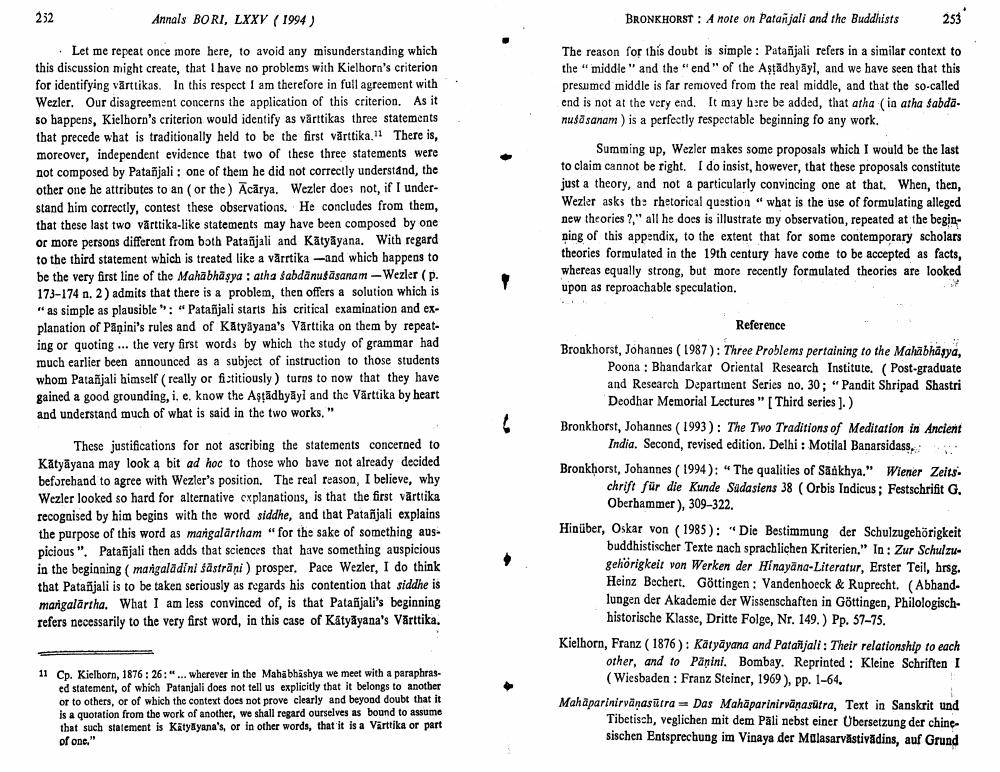Book Title: Note In Patanjali And The Buddhists Author(s): Johannes Bronkhorst Publisher: Johannes Bronkhorst View full book textPage 4
________________ Annals BORI, LXXV (1994) BRONKHORST : A note on Patanjali and the Buddhists 253 The reason for this doubt is simple : Patañjali refers in a similar context to the "middle" and the "end" of the Aştādhyāyl, and we have seen that this presumed middle is far removed from the real middle, and that the so-called end is not at the very end. It may here be added, that atha (in atha sabdanusasanam ) is a perfectly respectable beginning fo any work Let me repeat once more here, to avoid any misunderstanding which this discussion might create, that I have no problems with Kielborn's criterion for identifying varttikas. In this respect I am therefore in full agreement with Wezler. Our disagreement concerns the application of this criterion. As it so happens, Kielhorn's criterion would identify as Värttikas three statements that precede what is traditionally held to be the first vārttika." There is, moreover, independent evidence that two of these three statements were not composed by Patañjali: one of thein he did not correctly understand, the other one he attributes to an (or the ) Acārya. Wezler does not, if I understand him correctly, contest these observations. He concludes from them, that these last two varttika-like statements may have been composed by one or more persons different from both Patañjali and Katyāyana. With regard to the third statement which is treated like a vārrtika -and which happens to be the very first line of the Mahabhasya: atha sabdanusasanam-Wezler (P. 173-174 n. 2) admits that there is a problem, then offers a solution which is "as simple as plausible": "Patañjali starts his critical examination and explanation of Paņini's rules and of Katyāyana's Värttika on them by repeating or quoting ... the very first words by which the study of grammar had much earlier been announced as a subject of instruction to those students whom Patañjali himself really or fictitiously) turns to now that they have gained a good grounding, i. e. know the Astādbyāyi and the Värttika by heart and understand much of what is said in the two works." Summing up, Wezler makes some proposals which I would be the last to claim cannot be right. I do insist, however, that these proposals constitute just a theory, and not a particularly convincing one at that. When, then, Wezler asks th: rhetorical question "what is the use of formulating alleged new theories ?," all he does is illustrate my observation, repeated at the beginning of this appendix, to the extent that for some contemporary scholars theories formulated in the 19th century have come to be accepted as facts, whereas equally strong, but more recently formulated theories are looked upon as reproachable speculation. These justifications for not ascribing the statements concerned to Katyāyana may look a bit ad hoc to those who have not already decided beforehand to agree with Wezler's position. The real reason, I believe, why Wezler looked so hard for alternative explanations, is that the first vārttika recognised by him begins with the word siddhe, and that Patañjali explains the purpose of this word as margalärtham "for the sake of something auspicious". Patañjali then adds that sciences that have something auspicious in the beginning (margaladini $ästräni) prosper. Pace Wezler, I do think that Patañjali is to be taken seriously as regards his contention that siddhe is marigalartha. What I am less convinced of, is that Patañjali's beginning refers necessarily to the very first word, in this case of Katyāyana's Värttika. Reference Bronkhorst, Johannes (1987): Three Problems pertaining to the Mahabhasya, Poona : Bhandarkar Oriental Research Institute. (Post-graduate and Research Departinent Series no. 30; "Pandit Shripad Shastri Deodhar Memorial Lectures" (Third series ).) Bronkhorst, Johannes (1993): The Two Traditions of Meditation in Ancient India. Second, revised edition. Delhi : Motilal Banarsidass.. . Bronkhorst, Johannes (1994): "The qualities of Sankhya." Wiener Zeits: chrift für die Kunde Südasiens 38 (Orbis Indicus; Festschrifit G. Oberhammer), 309-322. Hinüber, Oskar von (1985): "Die Bestimmung der Schulzugehörigkeit buddhistischer Texte nach sprachlichen Kriterien." In: Zur Schulzugehörigkeit von Werken der Hinayāna-Literatur, Erster Teil, hrsg. Heinz Bechert. Göttingen: Vandenhoeck & Ruprecht. (Abhandlungen der Akademie der Wissenschaften in Göttingen, Philologisch historische Klasse, Dritte Folge, Nr. 149.) Pp. 57-75. Kielhorn, Franz (1876): Katyāyana and Patailjali: Their relationship to each other, and to Panini. Bombay. Reprinted : Kleine Schriften I (Wiesbaden: Franz Steiner, 1969), pp. 1-64. Mahaparinirvanasūtra Das Mahaparinirvänasutra, Text in Sanskrit und Tibetisch, veglichen mit dem Pāli nebst einer Übersetzung der chinesischen Entsprechung im Vinaya der Malasarvästivādins, auf Grund 11 Cp. Kiclhorn, 1876 : 26:"... Wherever in the Mahabhashya we meet with a paraphras ed statement, of which Patanjali does not tell us explicitly that it belongs to another or to others, or of which the context does not prove clearly and beyond doubt that it is a quotation from the work of another, we shall regard ourselves as bound to assume that such statement is Katyayana's, or in other words, that it is a Värttika or part of one."Page Navigation
1 2 3 4 5
